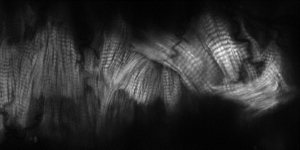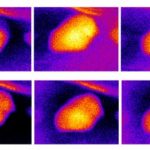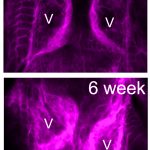
Every beat of the heart is finely tuned to eject a certain amount of blood. As we exercise, more blood flows into the heart, the cardiac muscle stretches and this leads to an increased force of contraction. Known as the Frank-Starling law, it is one of the most important aspects of human cardiac physiology but the molecular mechanisms are not entirely understood.
We do know that increases to the calcium levels in the heart cells (cardiomyocytes) support stronger contractions (anyone remember the ‘sliding ratchet model’ from GCSE biology!?) but how this calcium is regulated by stretch is not fully understood. What my colleagues and I have established (to be published in Frontiers of Physiology) is that a ‘mechanosensitive’ protein known as Piezo helps increase calcium when the cardiomyocytes are stretched. A lot of this work was done at BU’s Drosophila (fruit fly) genetics facility in Dorset House, using physiological tests of heart function in flies without the Piezo protein. When stretched, normal hearts respond by releasing more calcium and they continue to beat. In Piezo mutants, there’s no increase in calcium and the hearts often stop beating.
This is an important observation that contributes to our fundamental understanding of cardiac physiology and points to Piezo as a protein of considerable interest when considering the underlying causes of cardiac dysfunction in disease and ageing.
Paul Hartley.
(The image shows the contractile protein ‘scaffold’ within an insect heart)
 Kidneys are calciyummy!
Kidneys are calciyummy! Molecular basis for a healthier heart…new work published by BU
Molecular basis for a healthier heart…new work published by BU










 New Nepal scoping review on maternal & neonatal health
New Nepal scoping review on maternal & neonatal health Fourth INRC Symposium: From Clinical Applications to Neuro-Inspired Computation
Fourth INRC Symposium: From Clinical Applications to Neuro-Inspired Computation Writing policy briefs
Writing policy briefs Upholding Excellence: The Concordat to Support Research Integrity
Upholding Excellence: The Concordat to Support Research Integrity ECR Funding Open Call: Research Culture & Community Grant – Application Deadline Friday 12 December
ECR Funding Open Call: Research Culture & Community Grant – Application Deadline Friday 12 December MSCA Postdoctoral Fellowships 2025 Call
MSCA Postdoctoral Fellowships 2025 Call ERC Advanced Grant 2025 Webinar
ERC Advanced Grant 2025 Webinar Horizon Europe Work Programme 2025 Published
Horizon Europe Work Programme 2025 Published Horizon Europe 2025 Work Programme pre-Published
Horizon Europe 2025 Work Programme pre-Published Update on UKRO services
Update on UKRO services European research project exploring use of ‘virtual twins’ to better manage metabolic associated fatty liver disease
European research project exploring use of ‘virtual twins’ to better manage metabolic associated fatty liver disease
Hi,
Great research to read especially as I have just started a new job as a cardiac research nurse at Poole Hospital. I look forward to future updates upon this or new research you undertake.
Well done again.
Lucy
Thanks Lucy! I only just saw your comment and it is very much appreciated. Good luck with your new role, best wishes,
Paul.